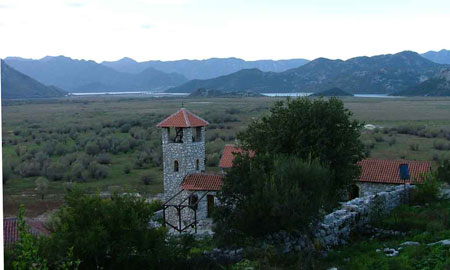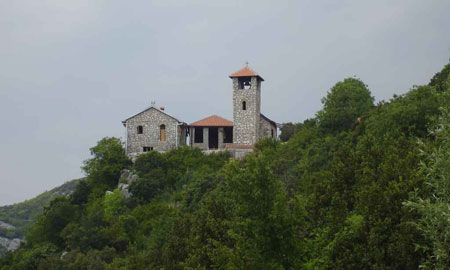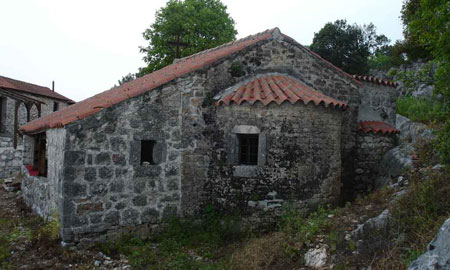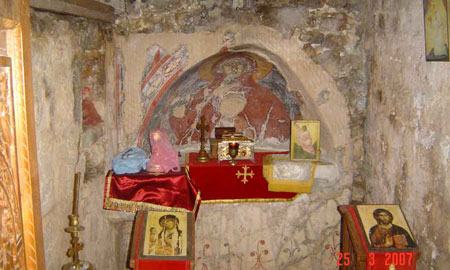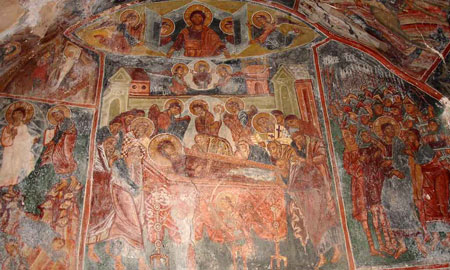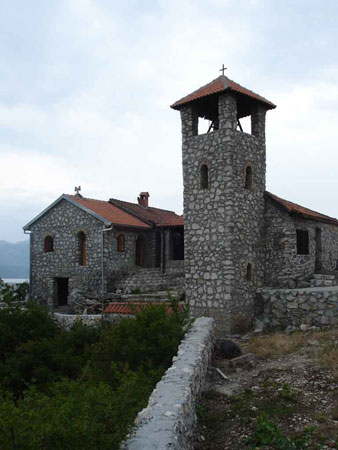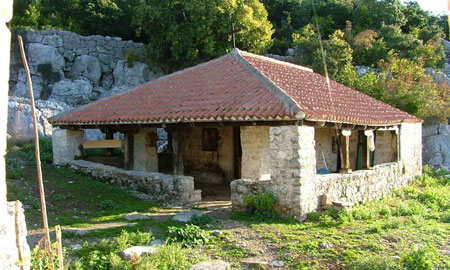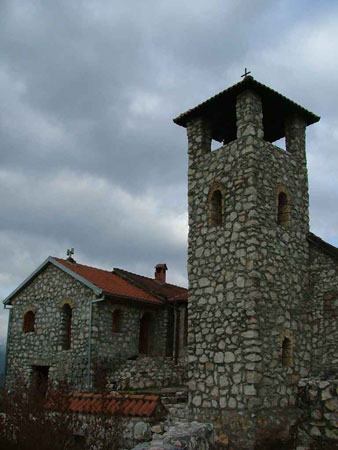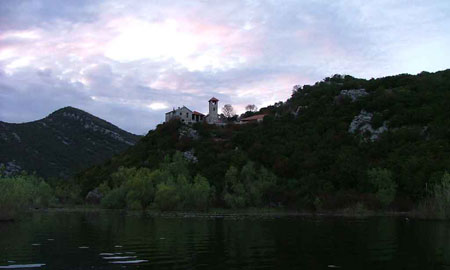The Monastery of Kom - Манастир Ком
The Monastery of Kom
In the line of medieval monasteries on Lake Skadar, the Monastery of Kom, founded by the Crnojevic family, takes special place. Built on the crest of Odrin Hill, far away from curious eyes, it is completely different from monasteries founded by the Balsic family, which are scattered throughout small forests in the Lake.
The Monastery of Kom is the foundation of Djurdje and Ljes Crnojevic. The church is dedicated to the Dormation of the Most Holy Mother of God. There are no historical sources about the church erection, but it is assumed that it was built between 1415 and 1427 year. During short time the Kom Monastery was the seat of Metropolitanate of Zeta, which is, after leaving the Monastery of St Archangel Michael on Prevlaka, via the Monastery of the Most Holy Mother of God of Krajnska and the Monastery of St. Nicolas on Vranjina, came to the Monastery of Kom.
The Monastery of Kom clearly speaks of difficult political circumstances of Montenegro in the time of the family Crnojevic. Turks were slowly approaching and the unpleasant balancing between Ottoman Empire and Venice, as well as a fight for the independence, forced the Crnojevic family to envelope their monasteries with discretion and make them inaccessible. The whole monastery complex very early got the appearance of fortification. The monastery lodgings were built on the west side of the island, strategically well located on the rock, with good view to everyone who, with either good or bad intention, was approaching Kom. The monastery was surrounded with protective wall and had two gates. In the time of its active life, the Monastery of Kom was very rich, because fertile soil, which is nowadays flooded by the lake, was then under vineyards, crops and pastures. Apart from the church, the remains of monastery lodgings also speak of the way of life of the brotherhood looking after the church property.
The Monastery of Kom had also accepted the tradition of burying family members in the church. It is proved by the document dated in the year of 1444 in which Kojicin Crnojevic is complaining to the Venice government in Skadar and Kotor and pleading to regain all the property that was taken away from monasteries and churches in the area of Lake Zeta which had been built by his predecessors and other Zeta rulers and in which all patrons were buried.
Such intensive life of the monastery didn’t last long, because when Zabljak fell in 1478 year Turks came to the immediate neighboring, so that as soon as 1485 year Ivan Crnojevic, in the charter of the foundation of the Monastery of Cetinje donates to The Mother of God in Cetinje all estates which previously belonged to the Monastery of Kom. However, the monastery wasn’t finally abandoned this time; around 1520 year the monastery was active again, but during seventeenth and eighteenth century it was almost deserted. Only the church continued its living, by being visited and opened.
The monastery church is simple building with central nave and in the middle of the fifteenth century it got two lateral small chapels and the wide wooden porch above them. The iconography was done twice, originally around 1470 year, and later during the eighties in the sixteenth century. It is the only church of Lake Skadar which still has got preserved fresco paintings.
In the middle of the last century the church was brought to life again by holding Service on Dormation of Most Holy Mother of God, when the people of Cetinje gathered in the Monastery of Kom. Since then priests, monks from neighbor monasteries and common religious people were maintaining the Monastery, both by repairing buildings and holding Divine Services. There are still some old people from nearby villages who remember great national gatherings in the Kom Monastery. With respect to the tradition of Zeta Metropolitanate and the glorious past of the Crnojevic family, young Njegos was in the Kom Monastery ordained archimandrite in the winter of 1831 year by Prizren Metropolitan.
During the eighties in the twentieth century some research works, building repairs and the conversation of fresco paintings were being carried out. But only with the arrival of hieromonk David (Miseljic) and monk Hrizostom (Nesic) in the Kom Monastery in 1998 year, with blessing of the Metropolitan of Montenegro and the Littoral, His Eminence Amfilohije (Radovic), the true reconstruction and spiritual life began in the Monastery of Kom. First abbot was hieromonk David (Miseljic) who because of his serious illness as soon as 1999 moved to St John `s valley, the hermitage of St John the Baptist – the property of the Monastery of Ostrog, where today his grave lies. Hieromonk David left to God in the year of 2004, in the hospital in Germany, after long treatment. Since 1999 year the present abbot, father Hrizostom (Nesic), with the help of God, under the protection of the Most Holy Mother of God to whom this monastery is dedicated, with his own effort and with help of pious people, is restoring and rebuilding, part by part , this great shrine.
Манастир Ком
У низу средњовековних манастира на Скадарском језеру, манастир Ком, задужбина Црнојевића, заузима посебно место. Подигнут на огранку Одринске горе, далеко од радозналих погледа, сасвим се разликује од манастира Балшића, посејаних по горицама Језера.
Манастир Ком је задужбина Ђурђа и Љеша Црнојевића. Црква на Кому је посвећена Успењу Пресвете Богородице. Не постоји историјски извор о подизању цркве, али се претпоставља да је сазидана између 1415. и 1427. године. Једно кратко време на Кому је било и седиште Зетске митрополије, која је, после напуштања манастира Св. Арханђела Михаила на Превлаци, преко Пречисте Крајнске и Св. Николе на Врањини дошла на Ком.
Ком речито говори о све тежим политичким приликама Црне Горе у доба Црнојевића. Турци су се полако приближавали, мучно балансирање између Отоманске империје и Венеције, као и борба за самосталност, натерали су Црнојевиће да и своје манастире заогрну дискрецијом и неприступачношћу. Читав комплекс манастира добио је веома рано изглед утврђења. Сама зграда конака подигнута је на западној страни острва, стратегијски добро лоцирана на стени, одакле се имао поглед на све оне који су се, у доброј или злој намери, приближавали Кому. Манастир је био опасан заштитним зидом и имао је две капије. У доба активног живота, манастир Ком је био веома богат, јер плодно земљиште, које данас плави Језеро, налазило се под виноградима, усевима и пашњацима. Поред цркве, остаци манастирских конака су сведочили о животу монаха који су се бринули о црквеним добрима.
Ком је такође прихватио и традицију гробних цркава. О томе сведочи један докуменат из 1444. године у којем се Којичин Црнојевић жали млетачким властима у Скадру и Котору и моли да се поврате сва одузета добра манастирима и црквама у Зетском језеру које су подигли његови стари и други зетски господари и у којима се сви они сахрањују.
Манастир није дуго интензивно живео, јер су падом Жабљака 1478. године Турци били у непосредном суседству, тако да већ 1485. године Иван Црнојевић, у повељи о оснивању Цетињског манастира прилаже Св Богородици на Цетињу, сва имања која су некада припадала цркви на Кому. Ипак, то није било и дефинитивно напуштање манастира; око 1520. године манастир је опет активан, да би током XVII и XVIII века манастир скоро запустео. Једино храм – црква наставља да живи, посећују је, отварају.
Манастирска црква је једноставна једнобродна грађевина која је средином XV века добила бочне параклисе и пространи дрвени трем који их обухвата. Живописана је у два маха, први пут око 1470. године а потом осамдесетих година XVI века. Једина је од цркава на Скадарском језеру која има сачуване фреске.
Средином прошлог века у њој је обновљена служба на дан Успења Пресвете Богородице, када су се на Кому окупљали Цеклињани. Одржавали су је у грађевинском и богослужбеном смислу свештена лица, монаси суседних манастира и народ. Још има старијег света из околних села који се сећа великих народних зборова на Кому. Поштујући традицију Зетске митрополије и славне прошлости Црнојевића, млади Његош је на Кому рукопроизведен од стране призренског митрополита за архимандрита у зиму 1831. године.
Осамдесетих година XX века извршени су делимично истраживачки радови, санација објеката и конзервација фресака. Доласком јеромонаха Давида (Мишељића) и монаха Хризостома (Нешића) 1998. године на Ком, с благословом митрополита Црногорско – приморског г.г. Амфилохија (Радовића), започела је обнова манастира Ком и духовног живота у њему. Први настојатељ манастира Ком био је јеромонах Давид (Мишељић) који због тешке болести већ 1999. године прелази у Јован до, скит Св. Јована Крститеља – метох манастира Острога, где се данас налази његов гроб. Јеромонах Давид представио се Господу 2004. године у болници у Немачкој после дужег лечења. Од 1999. године монах, садашњи игуман, отац Хризостом (Нешић) уз помоћ Божију, милошћу Пресвете Мајке Божије којој је манастир и посвећен, својим трудом и помоћу благоверног народа обнавља и подиже део по део те велике светиње.


